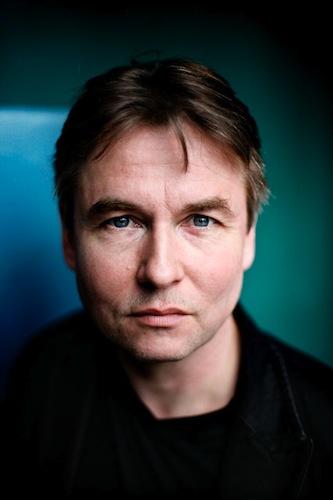Salonen, Philharmonic close season with multimedia wrap party

Esa-Pekka Salonen conducted the New York Philharmonic’s season-closing concert Friday night at David Geffen Hall. Photo: Katja Tahja
It was all hands on deck, plus eighteen feet on the floor, for the New York Philharmonic’s season closer on Friday, a one-night-only extravaganza for large orchestra, video, violin soloists, and nine dancers from the Boston Ballet.
The performance was also a wrap party for the three-year Philharmonic residency of composer Esa-Pekka Salonen, who led dynamic performances of two of his own works and the Violin Concerto by Daníel Bjarnason, with soloist Pekka Kuusisto.
The evening featured the world premiere of video artist Tai Rosner’s abstract art-in-motion partnering Salonen’s 2002 piece Foreign Bodies, and two firsts for New York: the Bjarnason concerto and Wayne McGregor’s not-so-abstract ballet interpretation of Salonen’s Lachen verlernt and Nyx as a sacrifice scenario à la The Rite of Spring.
With the players dressed in contemporary black shirts and pants, and Salonen’s self-sufficient and approachable music relegated to the role of soundtrack for visuals, the whole event seemed at times like a commercial to sell the coolness of the symphony orchestra to the unconvinced.
A large orchestra is loud! It’s got an extra-large drum kit that takes four people to play! There’s stuff to look at if you get bored! And a party afterward, with the kind of music you really like!
Well, it’s easy to make fun. There’s a time and place for everything, and maybe this was the time to make a pitch for the younger demographic that orchestras are so concerned about attracting. The core offering of the symphony orchestra—a hundred people working together in pinpoint coordination to produce compelling works of sonic art—was well represented Friday night.
Salonen’s Foreign Bodies was hardly his most probing music, but its mastery of the task at hand—described by the composer in a program note as “to write complex counterpoint for almost one hundred musicians playing tutti at full throttle without losing clarity of the different layers and lines”—was unquestionable.
With its echoes of Strauss and Ravel, of Bernstein and Gershwin, the energetic piece—played indeed mostly at full throttle—was as much a commercial for the symphonic repertoire of the last 120 years as for the band itself.
Rosner’s video response, projected on a large screen above the orchestra, ranged from the Fantasia-like obvious—fireworks tendrils for the winds, undulating ribbons for the strings—to the intriguingly indirect, as geometrical shapes came and went, suggesting at one point an enormous room, then passing trains, organ pipes, flower petals.
Here too, the video maker helped himself to the vocabulary of modern art, from Klee to Mondrian to Pollock, as his visuals roamed from room to room of the museum. (One wonders what he might do with Pictures at an Exhibition.)
The evening’s carefree atmosphere continued with Bjarnason’s fanciful Violin Concerto. The Icelandic composer’s one-movement opus opened with a bit of a parlor trick—soloist Kuusisto whistling along with his opening monologue, and the orchestra players whistling back. It then explored Bartókian nocturnal moods, dances with a touch of Latin syncopation (Bernstein again), and eventually Romantic-style virtuosity and vibrant singing lines. Kuusisto delivered it all with flair, colorfully partnered by Salonen and the orchestra.
Even this straight-up concerto performance had some extra visual interest, in the soloist’s samurai-topknot hairstyle and flowing attire, and his bow-waving, fiddle-pumping rockstar bows at the end.
Obsidian Tear—choreographer McGregor said his title can be pronounced either “tare” or “teer,” and embraced all possible meanings thereof—yoked together two Salonen scores, Lachen verlernt for unaccompanied violin and the orchestral fantasy Nyx to accompany stage action that was ambiguous at first but quite explicit by the close.
The all-male group of nine dancers, looking sculpted in vertical lighting, executed traditionally masculine moves with force and definition—especially the tall, brawny Junxiong Zhao in a sort of high-priest role—but also lifts, splits, and arabesques from ballet’s feminine vocabulary.
Simone Porter’s energetic performance of the fervent-to-furious, chaconne-like Lachen verlernt (“Forgetting How to Laugh,” a phrase from Schoenberg’s Pierrot lunaire) was played from the first box of the second tier over the thumping feet of dancers Derek Dunn and John Lam, enacting a scene of partnership and antagonism.
The full company of dancers, all in black except for Dunn’s flowing red track pants, performed to Salonen’s Nyx—originally an evocation of its namesake, a shadowy Greek goddess involved in the creation of the world. Salonen conducted a performance that plunged unapologetically, and brilliantly, into the extravagant sound worlds of Salome and Hollywood epics.
As the dance progressed, a red glow suffused an area below one corner of the stage, and eventually, sure enough, the dancer in red was chucked in there by his fellows.
In a program comment, Salonen expressed delight at how other artists’ response to his music helped him “discover that it has been communicating something that I honestly didn’t know was there.” No doubt that was the case with this Joe-versus-the-volcano scenario, as it was when Stravinsky saw dinosaurs tussling to The Rite of Spring.
Anyway, it was all in a good cause, and splendidly delivered by dancers and musicians alike. And the party in the foyer looked pretty convivial too—not exactly the New York Philharmonic subscription experience, but a nice invitation to it. You don’t get to drive the Honda they way they do in the commercials either, but you still buy it.


